Welcome to The Voyages and Travels of the Ambassadors, the epic story of a 17th century trade expedition from Germany to Persia that failed so completely its leader was publicly executed upon his return. This is Episode 25: Dogs, Pigs, Camels and Silk.
Last time we heard about the suburbs and agriculture of Isfahan, and now we will learn why, according to Persian lore, certain animals hate each other.
Of all the animals raised for food in Persia, there are more sheep than any other. The meat is not so pleasant for those unaccustomed to it, Olearius writes. The sheep are about the same size as those in Europe, but “short and flat-nosed with the ears hanging down” like some European dogs. They also have great flocks of goats. Candles are made from the fat, and leather from the skin, which is traded in Russia, Poland, and other countries. There is an abundance of buffalo, especially in provinces near the Caspian Sea, where some peasants have five or six hundred of them, and butter is made from their milk. Oxen are also common, but not slaughtered for their meat, and Olearius says he has been told that the cows will not allow themselves to be milked if their calves are not nearby. So if a calf happens to die, they fill its skin with straw, add a little salt, and let the cow lick it, by which means she stands quiet to be milked.
And then he relays a “ridiculous and obscene story” that he says is taken from the Qur’an.
One day, so the story goes, the apostles of Jesus ask him to tell them how it was that Noah lived in the ark during the flood. Without saying a word, Jesus picks up a handful of dirt, makes the figure of a man with it, and orders it to rise up in the name of Allah. An old man, unnaturally white, rises up from the soil.
Jesus asks him, “Who art thou?”
The old man says, “I am Japhet, the son of Noah.”
“Were you so white when you died?”
Japhet says no, and that he became white as a sheet only in this moment, out of fear that Allah had raised him up for the last judgement.
Jesus commands him to tell the apostles all that had transpired in the ark, and Japhet obeys. Among other things, Noah feared that too much manure was piling up on the lower decks, so he asked Allah what to do about it.
The answer was that the dung of a man and an elephant should be mixed together. Noah obeyed, and out of the mixture rose a pig. The pig – a nasty creature – filled its nostrils with filth and sneezed violently, producing a rat. This perplexed Noah, and so he addressed himself once more to Allah, asking what to do about the rat. The answer, Allah said, is to strike a lion on the head with a wand. Noah obeyed. The lion flew into a fury, and roared so loudly that out of his nostrils came a cat, which immediately killed the rat.
Noah knew he would live on the ark for a year, and so he separated the male and female animals out of fear that they would multiply and the ark would not be able to contain them. For some reason, however, Noah allowed only the two dogs to live together at the bottom of the ark. The cat saw this inequality – that the dogs had the liberty to mate, which was denied to all the other animals – and complained to Noah.
Noah reproached the dogs, but the dogs refused to acknowledge the truth of it. The cats repeatedly complained about the canine carnal sins, and Noah asked Allah to make the truth known by an irrefutable proof. Allah made it so, and the dogs became so desirous to lie together that they could not separate once they began to mate. The cat made sure to point this out, and Noah found the dogs guilty of lying to him.
“And so it is,” Olearius concludes the tale, “ever since that time, dogs have been so fastened in the act of generation, and have an inveterate feud against cats.”
Dogs do get stuck together when they mate, and dogs do chase cats. If you would like to know more about the former, ask your local veterinarian about something called “copulatory tie.” As for the latter, the canine hunting instinct is triggered by moving objects, so dogs hate cats about as much as they hate tennis balls.
Olearius does not explain why he thinks the story is ridiculous and obscene, but he is right about it. A modern Muslim myth from Southeast Asia about the origin of the pig helps demonstrate why. The tale goes like this:
Noah taught the people about the word of Allah but they did not follow him, so he asked Allah to send the flood. There were 40 days and nights of rain. Everyone outside the ship was drowned. As time went by, trouble arose in the ark. The animals defecated on the floor and rats appeared and ate everything, causing a lot of trouble. Noah asked Allah’s help, and he told Noah to pat the back of a tiger. When he did, a cat came out and ate the rats. Then Satan patted the elephant’s back and out came a pig. Noah asked Satan why he did it, and he said that he had seen Noah pat the tiger’s back so he decided to copy him. The pig, after it had come out, made a lot of filth and caused trouble. So Noah ordered the pig to be thrown into the sea.
Anyone familiar with the biblical story of the ark can see that Islam has added both Allah and Satan to the plot.
And it is no accident that dogs are liars, because Islamic culture teaches that dogs are impure and cannot be kept as pets. Cats, on the contrary, are truth-tellers, and Islam gives cats the highest possible status of all animals. They are allowed to live indoors, they are venerated, and they are portrayed essentially as smaller copies of lions and tigers, the “kings” of the jungle.
In the Muslim retelling of the flood, the virtuous cat rids the world of evil, while the dog, the pig, and the elephant are liars, unclean, and cause nothing but trouble because they obey Satan.
Islamic folk tales like this did not come from the Qur’an, but they did spread from the Middle East to Malaysia beginning in the 9th century and were written down and translated into local languages. Islam was officially introduced to the region in the 15th century, and mass conversions came soon after. Modern militant Islamic groups began their rise in the 1970s, and in 2001 Malaysia’s prime minister said the country was an Islamic state.
From the beginning of Islam, the Muslim message of superiority has been clear in both word and deed. Only Islam has the power to fix society’s evils – almost always at the point of a sword. And their folk tales say Buddhism only gives birth to rats and filth.
So perhaps it should not have been surprising when, in 2013, Buddhist monks in Southeast Asia – fed up with Islam’s centuries old public relations terror campaigns – started inciting mobs against Muslims. Since then, religious relations have not improved. In 2015, the Malaysian Defense Minister said he and several other leaders were on an Islamic State assassination list. By 2018, pro-Islamist political parties had achieved significant gains, in 2019 the Islamic State admitted to carrying out a wave of terrorist bombings in Sri Lanka, killing more than 250 and injuring more than 500, and in 2024 Buddhist monks are being imprisoned for Islamophobic hate speech.
But the news is not all bad. At least our modern Islamic republics are not – as we saw Tamerlane do in episode 23 – murdering 85% of the population of disobedient cities and building pyramids of skulls in the town square.
The Persians have several sorts of camels. The beasts are vindictive and they have a good memory.
As Olearius puts it, “The camels are very revengeful, and remember a long time any injury they have received, in so much, that, in Persia, a camel’s anger is come into a proverb, when they would speak of an irreconcilable enmity.”
Once upon a time, goes the proverb, there was a camel which had not been muzzled by his owner. The day was hot, the camel was agitated, and he bit a servant who happened to be walking by. The servant reacted by taking up a club and beating the camel about the neck, which is the most tender part of the animal. But the camel had a cruel revenge before they came to their journey’s end. Each night the servants slept near the camels, putting their feet under the bellies of the animals to keep warm. And on one of those cold nights, the abused camel got loose, found the servant who had beaten him, and stomped his body so that all his bones were crushed and broken.
Camels also hate horses, according to the Persians, and with good reason. For horses often sleep in the stables with a roof over their heads, while camels cannot get in because they are too tall and the stable doors are too low. Thus, the camels are forced to sleep outside, and for that they are angry at the horses.
Olearius does not believe the explanation, and notes that not only does every caravan he sees on his travels make use of camels, horses, and asses, but the animals are also put into the same stable without any difficulty.
He writes a great deal more about camels, which I will not include here except to say that the beasts are one of the greatest conveniences that travelers encounter in Persia. Usually hitched together in teams of seven, camels carry passengers, baggage, and cargo with little trouble. One man guides the team, and if he thinks it not safe to travel alone, he may join with the caravans that constantly crisscross the country, for this is the safest way of traveling. For two reasons the men tie little bells around their camels’ knees, and a big one around their necks. First, Olearius says, because the caravans are long and it is “necessary they should be heard at a great distance, to give those notice who might unadvisedly come between them.” And second because whipping or beating does not make them advance, but music – especially the bells or the sound of a man’s voice – animates and inspires them with a certain courage.
As we near the end of Book 6, and our ambassadors’ time in Isfahan, Olearius spends a significant amount of time discussing the violent Safavid line of succession, some of which we have already covered in previous episodes. He also expounds on Persian wine and Islam’s prohibition of it, which we have also previously covered.
One thing Olearius does not discuss at length is sericulture– the production of silk – which might be surprising, given that Duke Frederick’s mission is to reach a silk trade agreement between Persia and Holstein. But perhaps it is not so surprising after all, since that trade agreement never materializes. On numerous occasions, Olearius declines to recount salacious facts that would reflect badly on Duke Frederick or the mission, focusing instead on adventure in foreign lands with a kind of scientific observation not available in most contemporary travelogues. No doubt Olearius decided that his readers needed no reminder of Frederick’s failure, an editorial decision that the duke no doubt insisted upon.
From our modern perspective, this is an unfortunate oversight because there are no 17th century sources – either Persian or European – that describe the economics of silk production in Persia. Although we do have information from the early 1800s, there is no evidence that the same system existed when Olearius makes his observations in 1637. Some of what follows comes from a 1999 book by Rudolph Matthee, The Politics of Trade in Safavid Iran: Silk for Silver, 1600-1730.
What Olearius does say about silk is that it requires mulberry trees, and that Persians everywhere fill their gardens with these trees, planting them so close to one another that a man can hardly pass between them. The Persians call them bushes, and prune them so they do not grow taller than five and a half feet, the better to reach all the branches.
“In the spring, as soon as these trees begin to shoot forth their leaves, the Persians begin to hatch their silk worms,” Olearius writes. “To do this, they carry the eggs in a little bag under the armpit, where the heat of seven or eight days hatches them. Then they put them into a wooden dish, upon the mulberry-leaves, which they change at least once a day, having a great care that they be not wet.”
At the end of five days, the worms are moved into rooms that are kept clean and prepared for that purpose. In Kilan province, entire buildings are dedicated to the production of silk. A wooden latticework is nailed along the beams of these buildings, upon which are laid the most tender of the mulberry branches. The worms are placed on the leaves to feed, and the branches are changed every day until the worms have grown large.
The worms begin to spin silk after seven weeks, but until then women who are “troubled with their monthly infirmity” – as Olearius writes – must not come near them or the worms will die. How this might happen is not explained, but it has something to do with “smothering the worms in their own moisture,” a mysterious process which I admit I cannot fathom.
After two weeks of spinning, most of the silk cocoons are thrown into a kettle of boiling water. Some important details are not provided by Olearius, but in his 1738 book, Cornelius de Bruyn described the process he witnessed in the province of Shirvan in 1703:
“… at this work they require no more than the assistance of one person at a time. There was, on the right hand going in, a stove which they heated from without, and in which there was a great caldron of almost boiling water, in which were the cods of the worms. The person that wound off the silk sat upon this stove on one side of the caldron and with the small stick frequently removed the cods; in the small cottage I also observed a large wheel of eight or nine palms diameter, and which was fixed between two posts, which he turned with his foot as he sat upon the stove, just as we turn a spinning wheel; and before the stove there were two sticks, upon which there was a reed, round which turned two small pullies which guide the silk from the cods to the wheel. They assured me that this manner and method of winding off silk is the most common one all over Persia; and confessed it must be that this way they do it with surprising ease and dispatch.”
Some of the worms are allowed to complete the natural process, emerging as moths, mating, and laying new eggs before dying. The eggs are saved for the next year’s crop.
Not all the harvested silk is of the same quality, but it is more important that threads be wound separately according to thickness. The coarse threads tend to damage the fine threads, causing waste during the manufacturing process.
“In this commodity of silk consists the greatest trade of all Persia,” writes Olearius, “nay in a manner of all the East, as it is, in effect, the richest and most noble of any that is driven in Europe.” That is where his commentary ends, and so we must rely on Matthee for the rest.
We can’t be sure, but descriptions of the relationship between crown and private land during the 17th century make it likely that the sharecropping system of the early 1800s was also in effect in the mid-1600s.
In the 1800s, wrote Matthee, silk merchants distributed silkworm eggs among landowners. The landowners received interest-free loans or advances on the crops, and passed the eggs on to the cultivators. The cultivators received assistance from the landowners, and all three parties shared the profits from the cultivation. Sometimes, the landowner would rent his estate to the peasants who worked it for a fixed amount of silk.
The best silk is white, but yellow silk could also be quite good as long as it is clean and of good quality. As early as 1632, the Dutch complained about the poor quality of silk it received, and a common European complaint was that raw Persian silk was either dirty, damp, or of low quality. A representative of the English East India Company classified raw silk into three grades, ardas being the best, ardaset of the medium grade, and connorsee being the worst.
Much of the best silk was processed in Persia and used to produce fine cloth. Some was exported to India or the Levant, while almost none was sold to European markets. Of the remaining types, Europeans of course preferred the medium quality variety, but the worst kind was not unpopular. Some silk was mixed with cotton and was only suitable for manufacturing clothing.
The best silk was generally produced in Kilan province, and in 1638 one 5.6 kg load of the best sold for 45 tumans, the mid-grade for 36 tumans, and the poorest quality for 28 tumans. You will remember from previous episodes that the tuman was a unit of accounting, not a currency, and that in 1669 one tuman was worth about 3 English pounds sterling. Those prices remained relatively stable for the entire 17th century.
Production estimates vary widely, and are all from European sources because the Safavid empire fell in 1722 and its archives were destroyed by a relatively small army of Afghan tribesmen. At the turn of the 17th century, Robert Sherley said Persia’s total yield of silk was 34,000 bales. In 1635 the Dutch East India Company put the production at 1,073 bales, but said a “normal” year’s production was 4,000 bales, and 2,800 bales were produced in 1636. Olearius claimed an annual harvest of 20,000 bales, but it is not clear where he obtained that figure, and later Russian figures estimated that Kilan province alone produced 14,000 bales annually.
None of these estimates can be taken at face value because no European had a complete understanding of the national picture, and every European had reason – whether financial, political, religious, or military – to exaggerate or understate their numbers. The best guess provided by Matthee is that a good year saw the production of 8,000 bales of raw silk, while bad years due to natural disaster, disease, or warfare, might have cut that in half.
In the mid-1500s, English traders called the silk business “ready-money trade,” and said that all one needed to buy raw silk was pure silver. If it is understandable that Duke Frederick of Holstein wanted in on this easy money, it might also be assumed that Otto Bruggeman had not fully understood what else was involved.
Silk production in Persia was a local affair but a national business, and much of the trade was conducted door to door, bale by bale. A Dutch agent wrote that purchasing 100 bales of silk would require no fewer than 20 employees. The English and Dutch East India companies had existing trade networks, agents in place, and the ships to bring it home. Although transportation costs could have been minimized by going overland, Holstein was starting from scratch and paying significant tariffs to both Russia and Persia.
If Holstein had instead purchased their silk from the royal markets in Isfahan, that too had its own challenges. The government taxed silk heavily – as much as 30% – and paid an artificially lower price. Thus, as peasant producers have always done and still do today, the Persian peasants resorted to every possible subterfuge to under-report their production, to pay the least amount of tax, and to sell as much silk as possible to private buyers.
Silk was priced by weight, and the silk-producing regions near the Caspian Sea were more humid than Isfahan, so bales lost some 5% of their weight during transport. Sellers were also known to sprinkle water over the bales, leading Dutch buyers to dry them in the sun before paying.
Government functionaries – including the shah’s vizier, the treasurer, the city prefect, the chief of merchants, and other lesser officials – had to witness the weighing operation. Bales were weighed once by the Persians, a second time by the purchasers, and then packed by Muslim workers for shipment. To maximize Persian profits, workers routinely mixed different grades of silk together, and sometimes added rocks or rags during the packing process. Each bale contained a note with a packing number, the exact weight, and the grade of silk, which was signed by the company factor and his second in command. The final contract was signed only after at least half the bales had been packed, and everything was loaded onto camels, asses, and mules, for transport.
These caravans were almost always operated by Muslims. If the drivers were mostly Armenian then an Armenian would be chosen as leader, and if Turkish then the leader was also a Turk. Some caravans traveled west to Aleppo, in modern day Syria, or northwest through Anatolia to Istanbul. Others west south, crossing mountains and deserts on the way to the Persian Gulf. The journeys typically took two to four months.
Of course, if the Holstein mission had succeeded, their caravans would have traveled north to the Caspian, up the Volga, and thence to the Baltic. The Caspian shipping season extended from April to October, and Russian winters dictated that the last ship had to leave Persia by late August. The cargo vessels typically used by the Russians each had a capacity of 250 bales and followed the coastline to Astrakhan, where the silk was reloaded onto smaller riverboats and sent upstream to Saratov. From Saratov, which our ambassadors saw in episode 6, merchandise was loaded onto wagons for the trip to Moscow. These wagon caravans operated from May to late August, but an annual winter caravan also carried bales of silk by sled up the frozen Volga to Moscow.
The entire return trip on this new Silk Road envisioned by Duke Frederick would have taken about six months. But it never did happen, and as we reach the end of Book 6 and the end of 1637, our ambassadors are preparing for a discouraging trek back to Holstein.
Next time, we see Albrecht von Mandelslo tearfully leave his friends and start out for India, the company celebrates the new year of 1638 by firing cannons and hearing a sermon, they experience a near total eclipse of the sun, and we find out how Ambassador Bruggeman’s brain becomes so disordered that Adam Olearius fears he might not ever be his own man again, on the Voyages and Travels of the Ambassadors.

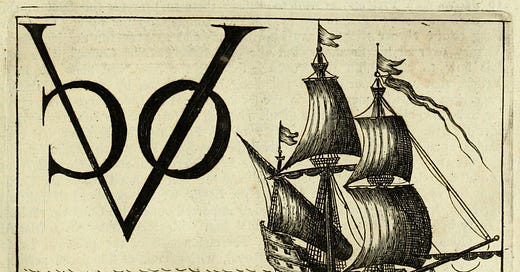





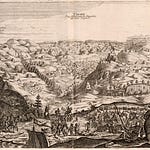
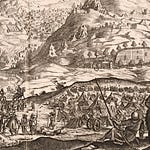
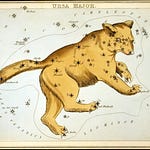


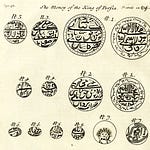
Share this post